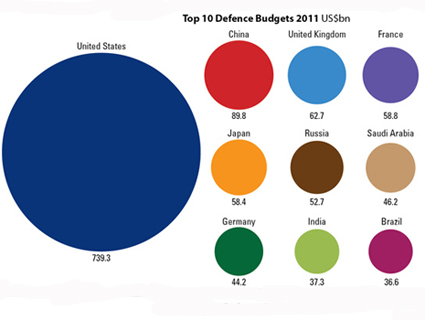
<a href="http://www.flickr.com/photos/truthout/6487269355/">Truthout.org</a>/Flickr
This story first appeared on the TomDispatch website.
If you’ve been fretting about faltering math education and falling test scores here in the United States, you should be worried based on this campaign season of Republican math. When it comes to the American military, the leading Republican presidential candidates evidently only learned to add and multiply, never subtract or divide.
![]() Advocates of Pentagon reform have criticized President Obama for his timid approach to reducing military spending. Despite current Pentagon budgets that have hovered at the highest levels since World War II and 13 years of steady growth, the administration’s latest plans would only reduce spending at the Department of Defense by 1.6 percent in inflation-adjusted dollars over the next five years.
Advocates of Pentagon reform have criticized President Obama for his timid approach to reducing military spending. Despite current Pentagon budgets that have hovered at the highest levels since World War II and 13 years of steady growth, the administration’s latest plans would only reduce spending at the Department of Defense by 1.6 percent in inflation-adjusted dollars over the next five years.
Still, compared to his main Republican opponents, Obama is a T. rex of budget slashers. After all, despite their stated commitment to reducing the deficit (while cutting taxes on the rich yet more), the Republican contenders are intent on raising Pentagon spending dramatically. Mitt Romney has staked out the “high ground” in the latest round of Republican math with a proposal to set Pentagon spending at 4 percent of the Gross Domestic Product (GDP). That would, in fact add up to an astonishing $8.3 trillion dollars over the next decade, one-third more than current, already bloated Pentagon plans.
Nathan Hodge of the Wall Street Journal engaged in polite understatement when he described the Romney plan as “the most optimistic forecast US defense manufacturers have heard in months.”
In fact, Romney’s proposal implies that the Pentagon is essentially an entitlement program that should receive a set share of our total economic resources regardless of what’s happening here at home or elsewhere on the planet. In Romney World, the Pentagon’s only role would be to engorge itself. If the GDP were to drop, it’s unlikely that, as president, he would reduce Pentagon spending accordingly.
Rick Santorum has spent far less time describing his military spending plans, but a remark at a Republican presidential debate in Arizona suggests that he is at least on the same page with Romney. In 1958, the year he was born, Santorum pointed out, Pentagon spending was 60 percent of the federal budget, and now it’s “only” 17 percent. In other words, why cut military spending when it’s so comparatively low?
Of course, this is a classic bait-and-switch case of cherry-picking numbers, since the federal budget of 1958 didn’t include Medicare, Medicaid, the Environmental Protection Agency, or the Occupational Safety and Health Administration. The population was 100 million less than it is now, resulting in lower spending across the board, most notably for Social Security. In fact, Americans now pay out nearly twice as much for military purposes as in 1958, a sum well in excess of the combined military budgets of the next 10 largest spending nations.
Of course, in a field of innumerates, Santorum’s claim undoubtedly falls into the category of rhetorical flourish. It’s unlikely that even he was suggesting we more than triple Pentagon spending—the only way to return it to the share of the budget it consumed in the halcyon days of his youth. (Keep in mind that profligate Pentagon spending in that era ultimately prompted President Dwight D. Eisenhower to coin the term “military-industrial complex.”) Still, Santorum clearly believes that there’s plenty of room to hike military spending, if we just slash genuine entitlement programs deeply enough. He would undoubtedly support a Pentagon budget at Romney-esque levels, as would Newt Gingrich based on his absurd claim that the Obama administration’s modest adjustments to the Pentagon’s record budgets would result in a “hollowing out” of the US military.
Mitt Romney at Sea
But let’s stick with the Republican frontrunner (or stumbler). What exactly would Romney spend all this money on?
For starters, he’s a humongous fan of building big ships, generally the most expensive items in the Pentagon budget. He has pledged to up Navy ship purchases from 9 to 15 per year, a rise of 50 percent. These things add up. A new aircraft carrier costs more than $10 billion; a ballistic missile submarine weighs in at $7 billion or more; and a destroyer comes with a—by comparison—piddling price tag of $2 billion-plus. The rationale for such a naval spending spree is, of course, that all-purpose threat cited these days by builders of every sort of big-ticket military hardware: China.
 As Romney put it late last year, if the US doesn’t pump up its shipbuilding budget, China will soon be “brushing aside an inferior American Navy in the Pacific.” This must be news to former Secretary of Defense Robert Gates, who noted in a May 2010 speech to the Navy League that the fleet is larger than the next 13 navies combined—11 of which, by the way, belong to US allies. As for the Chinese challenge, much has been made of China’s new aircraft carrier, which actually turns out to be a refurbished vessel purchased from Ukraine in 1998 and originally intended to be a floating casino. It would leave the US with only an 11 to 1 advantage in this category.
As Romney put it late last year, if the US doesn’t pump up its shipbuilding budget, China will soon be “brushing aside an inferior American Navy in the Pacific.” This must be news to former Secretary of Defense Robert Gates, who noted in a May 2010 speech to the Navy League that the fleet is larger than the next 13 navies combined—11 of which, by the way, belong to US allies. As for the Chinese challenge, much has been made of China’s new aircraft carrier, which actually turns out to be a refurbished vessel purchased from Ukraine in 1998 and originally intended to be a floating casino. It would leave the US with only an 11 to 1 advantage in this category.
It’s true that China is increasing the size of its navy in hopes of operating more freely in the waters off its coast and perhaps the contested South China Sea (with its energy reserves), but it is hardly engaged in a drive for global domination. It’s not as if Beijing is capable of deploying aircraft carriers off the coasts of California and Alaska. In the meantime, Romney’s shipbuilding fetish doesn’t add up. It’s as ludicrous as it is expensive.
Romney is also a major supporter of missile defense—and not just the current $9-$10 billion a year enterprise being funded by the Obama administration, primarily designed to blunt an attack by long-range North Korean missiles that don’t exist. Romney wants a “full, multi-layered” system. That sounds suspiciously like the Ronald Reagan-style fantasy of an “impermeable shield” over the United States against massive nuclear attack that was abandoned in the late 1980s because of its staggering expense and essential impracticality.
If the development of Romney’s high-priced version of a missile shield were again on the American agenda, it would be a godsend for big weapons-makers like Boeing, Lockheed Martin, and Raytheon, but would add nothing to the defense of this country. In fact, it stands a reasonable chance of making things worse. Given the overkill represented by the thousands of nuclear warheads in the American arsenal, the prospect of a nuclear missile attack on the United States is essentially nil.
As arms experts like Dr. Theodore Postol of the Security Studies Program at the Massachusetts Institute of Technology have pointed out, in the utterly unlikely event of a massive nuclear missile attack, Romney’s plan would be virtually useless. There’s just no way to provide a near-perfect defense against thousands of warheads and decoys launched at 15,000 miles per hour. The only reasonable defense against nuclear weapons would be to get rid of them altogether, a course suggested by scores of retired military leaders, former defense officials, and heads of state. Even Henry Kissinger has joined the “go to zero” campaign, supporting a far more sensible approach to the nuclear dilemma than Romney’s fantasy technical fix.
The Romney anti-missile program would, however, do more than just waste money. It would restore the Bush administration’s plan to emplace a long-range anti-missile system in Europe officially aimed at Iran but assumedly capable of taking out Russian missiles as well. Given that the Obama administration’s far more limited plan for Europe has already caused consternation among Russia’s leaders, imagine the harsh reaction in Moscow to the over-the-top Romney version. It could put an end to any hopes of further US-Russian nuclear reductions—a significant price to pay for a high-tech boondoggle with no prospect of success.
Ensuring a Cost-Overrun Presidency
If you were hoping that, with an eye to fighting yet more disastrous wars in the Greater Middle East like the $3 trillion fiasco in Iraq, the US would raise ever larger armies, then Mitt’s your man. While Secretary of Defense Leon Panetta’s latest plan would reduce the Army and Marines by about 100,000 over the next five years—essentially rolling back the increases that were part of the post-9/11 buildup—the former Massachusetts governor would double down by adding 100,000 more troops to present force levels.
His rhetoric and the bona fides of his neoconservative advisors suggest that one place President Romney might send those bulked up forces would be to Iran as “boots on the ground.” He has repeatedly claimed that, if President Obama is re-elected, Iran will get a nuclear weapon, and has asserted that if he is elected it will not. He has mocked the president for not being “tough enough” on the Iranians and implied that a Romney administration would consider force a go-to option against that country, rather than a threat meant to back up a diplomatic strategy.
Keep in mind that if Romney were to follow through on these costly undertakings and others like them, it would only add to the good old-fashioned waste and fraud that’s the norm of Pentagon contracting these days. As former head of the Joint Chiefs of Staff Admiral Mike Mullen pointed out, the post-9/11 national security spending binge played havoc with any sense of fiscal discipline at the Pentagon, eliminating the need to make “hard choices” or “limit ourselves” in significant ways. In his former position as Pentagon procurement czar, Under Secretary of Defense Ashton Carter acknowledged that “in a decade of ever-increasing defense budgets… it was always possible for our managers… when they ran into a technical problem or a difficult choice to reach for more money.”
Romney’s Republican math would ensure that this will continue. Defense giants like Lockheed Martin, whose F-35 combat aircraft has more than doubled in price over original projections, must be salivating at the prospect of another cost-overrun presidency, which would result in soaring profits and few punishments.
And let’s not forget the “spend more” brigades in the Republican House, led by Armed Services Committee Chairman Howard “Buck” McKeon (R-CA). Having received more than three quarters of a million dollars in campaign contributions from weapons contractors since 2009, he has never met a weapons system he didn’t like. Under a Republican administration, McKeon and his pork-barrel pals in Congress would have free rein to jack up spending on weapons and personnel with little concern for the impact on the deficit.
If a Republican president were to follow through on his campaign pledges, massive Pentagon increases and a dogged resistance to raising revenues would also result in major hits to every other item in the federal budget, from education to infrastructure. According to a report by the Center on Budget and Policy Priorities, the Romney budget plan could cut domestic discretionary programs by as much as 50 percent over the next 10 years.
In an April 1967 speech against the Vietnam War, Martin Luther King assailed the buildup for that conflict as a “demonic destructive suction tube” that drew “men, money, and skills” away from solving urgent national problems. Romney’s military buildup would waste far more money than was expended during the Vietnam years. His presidency would exceed King’s worst nightmare. When will someone ask him to explain his fuzzy math?
William D. Hartung is the director of the Arms and Security Project at the Center for International Policy, a TomDispatch regular, and the author of Prophets of War: Lockheed Martin and the Making of the Military-Industrial Complex. (To listen to Timothy MacBain’s latest Tomcast audio interview in which Hartung discusses how to manipulate Pentagon budgets, click here, or download it to your iPod here.) Follow TomDispatch on Twitter @TomDispatch and join us on Facebook. To stay on top of important articles like these, sign up to receive the latest updates from TomDispatch.com here.

















